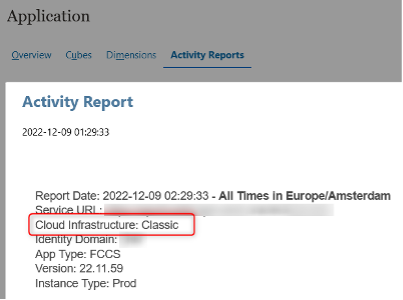Share this
What the mandatory migration to OCI for Oracle EPM Cloud means for you
by Bert Dotinga
Oracle is pushing all Oracle EPM cloud users to OCI, the latest Oracle Cloud Infrastructure. Is your organization on a ‘Classic’ data center? Oracle is planning to move your EPM application to OCI in 2023. This migration is mandatory; however, you can choose from 2 scenarios. Discover more details about the migration to OCI and the different options.

What is OCI?
First of all, let’s have a look at OCI. OCI stands for Oracle Cloud Infrastructure, also known as Generation 2 or Gen2. OCI is the latest infrastructure, and the reason behind this mandatory migration is that Oracle aims to standardize all data centers on the OCI architecture.
If your organization is already on the new OCI, you will have no impact, and you don’t have to do anything. You will have to take action if you are on a ‘Classic’ data center, also known as Gen1. In that case, Oracle plans to move your EPM application in 2023 to OCI.
How to check if you have to migrate to OCI?
So how do you know if you are on a ‘Classic’ data center? In a few easy steps, you can check which generation cloud infrastructure you’re currently using:
- Check the activity report in your EPM application.
- Go to Application > Overview > Activity reports.
- At the top of the activity report, you’ll see if you are on the ‘Classic’ (Gen1) or ‘OCI’ (Gen2) data center.
In the example shown below, the application is on the ‘Classic’ (Gen1) data center, meaning migration to OCI is applicable and mandatory.

Benefits of the OCI data center
Even though the migration is made mandatory by Oracle, the new infrastructure offers some great features.
Some of the most notable features of OCI are:
- Multiple-day backups. Before, you had only 1 daily backup by default. With OCI, you have 60 days of backup of your production application and 30 days of backup of your test application.
- Set your own password policy.
- Avoid using passwords (and therefore periodic reset) when using REST APIs or EPM Automate and EPM Integration Agent via OAuth 2 support.
- Customization of Notifications. You can modify the email template for new users, with, for example, the url for Smart View, link to instructions or support, etc.
- Database encryption using AES-256.
How to choose the right migration option to OCI
You can choose from 2 different scenarios for this move. Oracle calls these options ‘customer-managed migration’ or ‘Oracle-managed migration’.
With the Oracle-managed migration, you have less time to test the applications. Also, you do not yet know the timeframe; the timeframe cannot be chosen but is set by Oracle. As the current url will remain (it will be redirected to the new environment), the impact on setup and end-users is limited. At the end of the 2 months, during the Oracle monthly updates, test- and production application(s) will be updated respectively the first and the third Friday of the month.*
With a customer-managed migration, you have more time & control over the process, but you will have to choose a new url. This requires additional work, as you must inform users, update Smartview connections, check your interface (url)setup, etc. In addition, you will have to update the OCI environments before go-live to be in sync again.
*Oracle now additionally provides the possibility to request a loaner environment on Gen2 infrastructure, so you can familiarize yourself with OCI (Gen 2). Loaner environments can be used for up to three months.
3 critical considerations for the migration to OCI
Whichever option you choose, there are three critical elements you need to consider in both scenarios:
- Testing! This remains crucial in any migration.
- For both options, you will need to do several things yourself. At the very least, do the following yourself (for testing purposes):
-
- Copy the instances from classic to OCI environments
- Complete testing for all applications
3. Limit or avoid any configuration changes during the migration process to limit (or prevent) the impact on your test process.
Timeline mandatory migration to OCI
The best option depends on your situation and requirements. However, it is vital to make a choice. If you do nothing, Oracle will choose for you. Around April 2023, Oracle will start sending notifications for Oracle-managed migrations to any customer who has not requested customer-managed migration by that time. This means you will receive an email with a scheduled migration timeframe, which may be as soon as April 2023.
If you choose the customer-managed migration, we advise you to start the process as soon as possible. Also, don’t forget to let Oracle know that you prefer this option.
Need assistance with your migration to OCI?
We can understand the above is a lot to comprehend. Please let our colleague Bert know if you need any advice on the options or just want some additional information. We can also guide you in the migration process and help in cloning and testing the environment.
Webinar: How to choose the best migration scenario for your organization
Discover all the ins and outs and how to choose the best migration scenario for your organization. Please register and watch the webinar directly.
Share this
- March 2025 (2)
- February 2025 (2)
- December 2024 (1)
- July 2024 (3)
- April 2024 (2)
- March 2024 (1)
- February 2024 (1)
- January 2024 (3)
- December 2023 (1)
- June 2023 (1)
- April 2023 (1)
- March 2023 (1)
- December 2022 (1)
- September 2022 (1)
- August 2022 (2)
- March 2022 (1)
- February 2022 (1)
- December 2021 (1)
- May 2021 (15)
- April 2021 (24)
